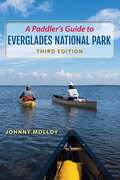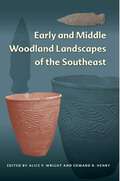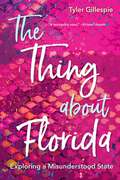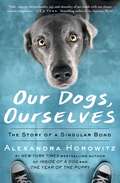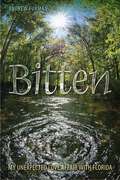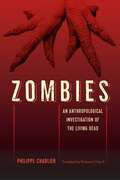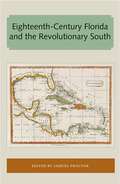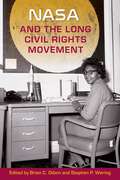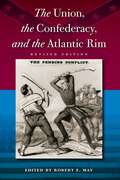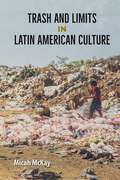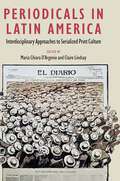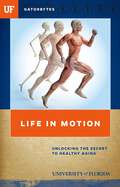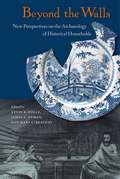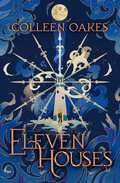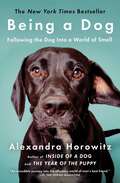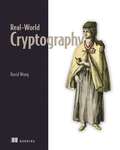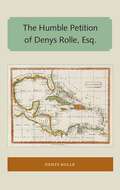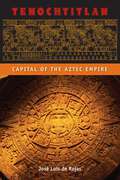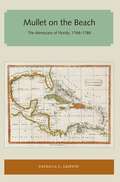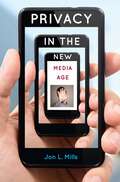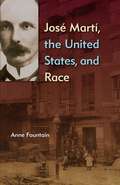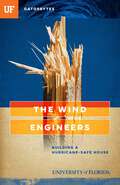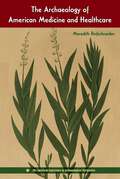- Table View
- List View
A Paddler's Guide to Everglades National Park
by Johnny MolloyWhether forging uncharted territory or slipping along marked canoe trails, get ready to experience more than 400 miles of creeks, bays, marshes, and the Gulf of Mexico. This indispensable guide for the ultimate adventure by canoe or kayak now includes GPS coordinates and twelve new paddle routes.
Early and Middle Woodland Landscapes of the Southeast (Florida Museum of Natural History: Ripley P. Bullen Series)
by Alice P. Wright and Edward R. HenryFourteen in-depth case studies incorporate empirical data with theoretical concepts such as ritual, aggregation, and place-making, highlighting the variability and common themes in the relationships between people, landscapes, and the built environment that characterize this period of North American native life in the Southeast.
The Thing about Florida: Exploring a Misunderstood State
by Tyler GillespieA journey beyond fears and stereotypes The memes. “Because Florida” jokes. “Florida Man” stories. Tyler Gillespie was once embarrassed to call Florida home, concocting fantasies he’d been born somewhere else. In The Thing about Florida, Gillespie faces his Florida denial and takes readers on an exuberant search for the state behind the caricatures, cutting through the media storm with curiosity and humor. Gillespie’s journey leads him into unexpected places such as halfway houses, gator pits, rattlesnake rooms, and clothing-optional campgrounds, where he meets eclectic and unconventional Floridians. He interviews storm chasers, Civil War reenactors, cattle ranchers, drag queens, python hunters, and pet smugglers. His conversations delve into serious issues such as addiction, Florida’s racist past, and care options for the state’s LGBTQ senior citizens. With perspective and empathy derived from his background as a gay man raised Southern Baptist, Gillespie shows how important it is to understand the diversity and complexity of Florida today. “It’s dangerous to meet our fears with fear,” he says as he confronts his own as well as the state’s monsters—invasive species, hurricanes, environmental destruction. He reminds us that Florida’s people and problems are vital parts of the nation’s future. A fresh and engaging voice, Gillespie captivates with a snappy pace, sly wit, and crisp observations. As he weaves his childhood memories and personal experiences alongside the stories of the individuals he encounters, Gillespie reconciles with his home state. He finds Florida’s humanity, a beautiful mix of hopes, dreams, and second chances.
Our Dogs, Ourselves: The Story of a Singular Bond
by Alexandra HorowitzFrom the #1 New York Times bestselling author of Inside of a Dog and The Year of the Puppy, an eye-opening, informative, &“entertaining, and enlightening&” (BookPage) celebration of the human-canine relationship for the curious dog owner and science-lover alike.We keep dogs and are kept by them. We love dogs and (we assume) we are loved by them. We buy them sweaters, toys, shoes; we are concerned with their social lives, their food, and their health. The story of humans and dogs is thousands of years old but is far from understood. In Our Dogs, Ourselves, Alexandra Horowitz explores all aspects of this unique and complex relationship that &“dog lovers will savor and absorb&” (Shelf Awareness). As Horowitz considers the current culture of dogdom, she reveals the odd, surprising, and contradictory ways we live with dogs. We celebrate their individuality but breed them for sameness. Despite our deep emotional relationships with dogs, legally they are property to be bought, sold, abandoned, or euthanized as we wish. Even the way we speak to our dogs is at once perplexing and delightful. In thirteen thoughtful and charming chapters, Our Dogs, Ourselves affirms our profound affection for this most charismatic of animals—and makes us &“see canine companions in new ways&” (Science News).
Istwa across the Water: Haitian History, Memory, and the Cultural Imagination
by Toni Pressley-SanonHonorable Mention, Latin American Studies Association Haiti-Dominican Republic Section Isis Duarte Book Prize Gathering oral stories and visual art from Haiti and two of its "motherlands" in Africa, Istwa across the Water recovers the submerged histories of the island through methods drawn from its deep spiritual and cultural traditions. Toni Pressley-Sanon employs three theoretical anchors to bring together parts of the African diaspora that are profoundly fractured because of the slave trade. The first is the Vodou concept of marasa, or twinned entities, which she uses to identify parts of Dahomey (the present-day Benin Republic) and the Kongo region as Haiti's twinned sites of cultural production. Second, she draws on poet Kamau Brathwaite's idea of tidalectics—the back-and-forth movement of ocean waves—as a way to look at the cultural exchange set in motion by the transatlantic movement of captives. Finally, Pressley-Sanon searches out the places where history and memory intersect in story, expressed by the Kreyòl term istwa. Challenging the tendency to read history linearly, this volume offers a bold new approach for understanding Haitian histories and imagining Haitian futures.
Bitten: My Unexpected Love Affair with Florida
by Andrew FurmanWhen Andrew Furman left the rolling hills of Pennsylvania behind for a new job in Florida, he feared the worst. While he’d heard much of the fabled “southern charm,” he wondered what could possibly be charming about fist-sized mosquitoes, oppressive humidity, and ever-lurking alligators.It wasn’t long before he began to notice that the real Florida right outside his office window was very different from the stereotypes portrayed in movies, television, and even state-promoted tourism advertisements. In Bitten, Furman shares his amazement at the beautiful and the bizarre of his adopted state. Over seventeen years, he and his family have shed their Yankee sensibilities and awakened to the terra incognita of their new home.As he learns to fish for snook—a wily fish that inhabits, among other areas, the concrete-lined canals that crisscross the state—and seeks out the state’s oldest live oak, a behemoth that pre-dates Columbus, Furman realizes that falling in love with Florida is a fun and sometimes humbling process of discovery. Each chapter highlights a fascinating aspect of his journey into the natural environment he once avoided, from snail kites to lizards and cassia to coontie.Sharing his attempts at night fishing, growing native plants, birding, and hiking the Everglades, Furman will inspire you to explore the real Florida. And, if you aren’t lucky enough to reside in the Sunshine State, he’ll at least convince you to unplug for an hour or two and enjoy the natural beauty of wherever it is you call home.
Zombies: An Anthropological Investigation of the Living Dead
by Philippe Charlier“A compelling account of the zombi as an anthropological reality and evocative symbol of a state of dispossession, desperation, and death.”—Roger Luckhurst, author of Zombies: A Cultural History “An adventurer’s anthropological quest offering a novel description of the contemporary zombie.”—Sarah J. Lauro, author of The Transatlantic Zombie: Slavery, Rebellion, and Living Death “Displays an empathy for the cultural reality of the zombie in Haiti that delivers important insight on the island nation’s people and their lived realities.”—Christopher M. Moreman, coeditor of Race, Oppression and the Zombie: Essays on Cross-Cultural Appropriations of the Caribbean Tradition Forensic pathologist Philippe Charlier—dubbed the “Indiana Jones of the graveyards”—travels to Haiti where rumors claim that some who die may return to life as zombies. Charlier investigates these far-fetched stories and finds that, in Haiti, the dead are a part of daily life. Families, fearing that loved ones may return from the grave, urge pallbearers to take rambling routes to prevent the recently departed from finding their way home from cemeteries. Corpses are sometimes killed a second time…just to be safe. And a person might spend their life preparing their funeral and grave to ensure they will not become a wandering soul after death. But are the stories true? Charlier’s investigations lead him to Vodou leader Max Beauvoir and other priests, who reveal how bodies can be reanimated. In some cases, sorcerers lure the dead from their graves and give them a potion concocted from Devil’s Snare, a plant more commonly known as Jimsonweed. Sometimes secret societies use poudre zombi—“zombie powder”—spiked with the tetrodotoxin found in blowfish. Charlier eagerly collects evidence, examining Vodou dolls by X-ray, making sacrifices at rituals, and visiting cemeteries under the cloak of night. Zombies follows Charlier’s journey to understand the fascinating and frightening world of Haiti’s living dead, inviting readers to believe the unbelievable.
Eighteenth-Century Florida and the Revolutionary South (Florida and the Caribbean Open Books Series)
by Samuel ProctorThe books in the Florida and the Caribbean Open Books Series demonstrate the University Press of Florida’s long history of publishing Latin American and Caribbean studies titles that connect in and through Florida, highlighting the connections between the Sunshine State and its neighboring islands. Books in this series show how early explorers found and settled Florida and the Caribbean. They tell the tales of early pioneers, both foreign and domestic. They examine topics critical to the area such as travel, migration, economic opportunity, and tourism. They look at the growth of Florida and the Caribbean and the attendant pressures on the environment, culture, urban development, and the movement of peoples, both forced and voluntary. The Florida and the Caribbean Open Books Series gathers the rich data available in these architectural, archaeological, cultural, and historical works, as well as the travelogues and naturalists’ sketches of the area in prior to the twentieth century, making it accessible for scholars and the general public alike. The Florida and the Caribbean Open Books Series is made possible through a grant from the National Endowment for the Humanities and the Andrew W. Mellon Foundation, under the Humanities Open Books program.
NASA and the Long Civil Rights Movement
by Brian C. Odom and Stephen P. WaringAmerican Astronautical Society Eugene M. Emme Astronautical Literature Award <p><p> As NASA prepared for the launch of Apollo 11 in July 1969, many African American leaders protested the billions of dollars used to fund “space joyrides” rather than help tackle poverty, inequality, and discrimination at home. This volume examines such tensions as well as the ways in which NASA’s goal of space exploration aligned with the cause of racial equality. It provides new insights into the complex relationship between the space program and the civil rights movement in the Jim Crow South and abroad. <p><p> Essays explore how thousands of jobs created during the space race offered new opportunities for minorities in places like Huntsville, Alabama, while at the same time segregation at NASA’s satellite tracking station in South Africa led to that facility’s closure. Other topics include black skepticism toward NASA’s framing of space exploration as “for the benefit of all mankind,” NASA’s track record in hiring women and minorities, and the efforts of black activists to increase minority access to education that would lead to greater participation in the space program. The volume also addresses how to best find and preserve archival evidence of African American contributions that are missing from narratives of space exploration. <p><p> NASA and the Long Civil Rights Movement offers important lessons from history as today’s activists grapple with the distance between social movements like Black Lives Matter and scientific ambitions such as NASA’s mission to Mars.
The Union, the Confederacy, and the Atlantic Rim
by Robert E. MayFrom French intervention in Mexico to British interests in the Caribbean, the impact of the Civil War extended far beyond military campaigns in Virginia, diffusing widely into the Atlantic world. Revised to take into account the outpouring of scholarship on Civil War diplomacy that has appeared since the book was first published, The Union, the Confederacy, and the Atlantic Rim features essays by acclaimed historians Howard Jones, R. J. M. Blackett, Thomas Schoonover, and James M. McPherson.
Trash and Limits in Latin American Culture
by Micah McKayThe ecological, social, and aesthetic functions of garbage in literature and film from Argentina to Mexico This book looks at the role of waste in Latin American cultural texts from the twentieth and twenty-first centuries and makes the case for foregrounding trash as an object of analysis in literary and cultural studies in Spanish America and Brazil. By considering how writers and filmmakers engage with the theme, Micah McKay argues that garbage illuminates key limits related to the region’s experience with contemporary capitalism. Recognizing trash as an important social reality, McKay traces its appearance in a diverse range of products: novels and documentary films with dumps as settings, short stories whose main characters are garbage pickers, and works that portray writing as a process of piecing together found materials. McKay argues that waste and the problems it poses are key to understanding marginalization, political struggle, and the production of aesthetic value. Drawing on insights from material ecocriticism, discard studies, and biopolitics, McKay theorizes that trash opens a space of reflection on what it means to be human, the possibilities for building community amid catastrophe, gendered notions of labor and care, and the pitfalls of neoliberal environmentalism. McKay shows how trash in literature and film helps readers and viewers contemplate the limits of how we inhabit the planet. Publication of this work made possible by a Sustaining the Humanities through the American Rescue Plan grant from the National Endowment for the Humanities.
Periodicals in Latin America: Interdisciplinary Approaches to Serialized Print Culture (Reframing Media, Technology, and Culture in Latin/o America)
by Claire Lindsay Maria Chiara D'ArgenioExploring how Latin American print culture has informed global exchange The first volume in English to focus on Latin American serialized print culture, Periodicals in Latin America assembles research on a diverse range of publications, including avant-garde reviews, comics, specialized journals, mass-market magazines, and political periodicals, from the late nineteenth century to the present day. In this book, scholars from a variety of disciplines examine both celebrated and little-known periodicals to demonstrate how publications supported emerging movements such as Indigenismo and feminism; undermined hegemonic conceptions of statehood and national identity; and questioned ideas about the relationship between the visual, literary, and political. Bringing Latin American print culture together with research and theories from the largely Anglophone field of periodical studies, this volume contests readings that discount the region’s periodicals, situating Latin America as a contributor to—not just a recipient of—global exchanges. Contributors also challenge the idea that periodicals are only useful for the insights they can offer into history, championing close attention to their material and materiality. The writers in this book reflect on the unique qualities and divergences of the region’s periodicals from those of other parts of the world and the need for different approaches to studying them. The volume bridges and brings into dialogue new research on print serials and their readers in the Spanish-, Portuguese-, and English-speaking worlds. Contributors: Joanna Crow | María del Pilar Blanco | José Chávarry | Jorge Catalá | Isabella Cosse | M. Paula Bontempo | Sandra Szir | Camilla Sutherland | Luis Rebaza-Soraluz | Claire Lindsay | Valentino Gianuzzi | Sofía Mercader | Rielle Navitski | Luz Ainaí Morales Pino | Maria Chiara D’Argenio A volume in the series Reframing Media, Technology, and Culture in Latin/o America, edited by Héctor Fernández L’Hoeste and Juan Carlos Rodríguez
Life in Motion: Unlocking the Secret to Healthy Aging
by University of FloridaThe University of Florida has an ambitious goal: to harness the power of its faculty, staff, students, and alumni to solve some of society’s most pressing problems and to become a resource for the state of Florida, the nation, and the world. In the upcoming decades, an unprecedented demographic shift will take place; the eighty-five and over population is projected to climb far higher than any other age group. To keep the current elderly population healthy and help prevent future generations from experiencing poor health outcomes, researchers are studying crucial connections between skeletal muscles and whole-body health. The University of Florida is at the forefront of this research, utilizing its nationally recognized excellence in the fields of muscle biology and exercise physiology to discover unique ways to preserve muscle health in the aging and those with diseases. Find out how the proteins within muscle can be manipulated to reduce recovery times for individuals who are bedridden. Learn how older, elite athletes have resisted the inevitable degeneration that comes with aging, and how intermittent fasting may help you live longer and healthier. Step inside the lab where a researcher is uncovering the origins of cancer cachexia—a wasting syndrome responsible for 20 percent of cancer deaths worldwide—to improve the lives of patients. The loss of skeletal muscle through disease, disuse, or aging is associated with a host of poor health outcomes, but promising new avenues of research are being studied every day at the University of Florida to make for a healthier tomorrow. The stories chronicled in GATORBYTES span all colleges and units across the UF campus. They detail the far-reaching impact of UF’s research, technologies, and innovations—and the UF faculty members dedicated to them. Gatorbytes describe how UF is continuing to build on its strengths and extend the reach of its efforts so that it can help even more people in even more places.
Beyond the Walls: New Perspectives on the Archaeology of Historical Households
by Kevin R. Fogle, James A. Nyman and Mary C. Beaudry“Thought-provoking and engaging, Beyond the Walls provides new and relevant theoretical perspectives and specific case studies for archaeologists conducting research related to household archaeology. Essential for both students and professionals.”—Mark D. Groover, author of The Archaeology of North American Farmsteads “From ranching stations in Hawai’i to slave quarters in South Carolina, the essays in Beyond the Walls crosscut time and space to consider the interrelationships between households and the wider regional and global networks in which their residents were enmeshed, presenting new insights relating to identity, consumerism, and modernity.”—Barbara J. Heath, coeditor of Jefferson’s Poplar Forest: Unearthing a Virginia Plantation While household archaeologists view the home as a social unit, few move their investigations “beyond the walls” when contextualizing a household in its community. Even exterior aspects of a dwelling—its plant life, yard spaces, and trash heaps—uncover issues of domination and resistance, gender relations, and the effects of colonialism. This innovative volume examines historical homes and their wider landscapes to more fully address social issues of the past. The contributors, leading archaeologists using various interpretive frameworks, analyze households across time periods and diverse cultures in North America. Including case studies of James Madison’s Montpelier, George Washington’s Ferry Farm, Chinese immigrants in a Nevada mining town and Southern plantations, Beyond the Walls offers a new avenue for archaeological study of domestic sites.
Eleven Houses
by Colleen OakesTwilight meets The Mist in this &“fresh, atmospheric paranormal romance&” (Booklist) about a mysterious island and the houses who have stood for centuries to guard against the dreaded nightmare of beings waiting to strike from the ocean&’s depths.On a forgotten part of Nova Scotia, there lies an island. On that island are Eleven Houses. In those houses sit eleven ancient families. And they are waiting… Mabel is one of the last surviving members of House Beuvry, one of the eleven houses on the haunted island of Weymouth. Her days, like all the other teens on the island, are spent readying her house for The Storm: a once-a-decade event that pummels the island with hurricane-level wind, water, and waves. But that&’s not all the Storm brings with it—because Weymouth Island is a gate between the worlds of the living and the dead. When Miles Cabot arrives on Weymouth Island after the death of his mother, he realizes quickly it isn&’t like other places—and Mabel Beuvry isn&’t like other teenagers. There&’s an intense chemistry between Miles and Mabel that both feel, yet neither understand—nor the deadly consequences that will come with it. With the suspicious death of an island elder, a strained dynamic with her younger sister Hali, and the greatest Storm in years edging ever closer, Mabel&’s life is becoming as chaotic as the weather. One thing becomes clear: if the fortified houses of Weymouth Island can&’t stand against the dead, then she—and everyone she loves—will pay the price. Fares Well the House That&’s Ready.
Being a Dog: Following the Dog Into a World of Smell
by Alexandra HorowitzFrom the #1 bestselling author of Inside of a Dog and The Year of the Puppy—&“an incredible journey into the olfactory world of man&’s best friend&” (O, The Oprah Magazine), Alexandra Horowitz&’s follow-up to her New York Times bestseller explains how dogs experience the world through their most spectacular organ—the nose.In her &“fascinating book…Horowitz combines the expertise of a scientist with an easy, lively writing style&” (The New York Times Book Review) as she imagines what it is like to be a dog. Guided by her own dogs, Finnegan and Upton, Horowitz sets off on a quest through the cutting-edge science behind the olfactory abilities of the dog. In addition to speaking to cognitive researchers and smell experts, Horowitz visits detection-dog trainers and training centers; she meets researchers working with dogs to detect cancerous cells and anticipate epileptic seizure or diabetic shock; and she even attempts to smell-train her own nose. As we come to understand how rich, complex, and exciting the world around us is to the canine nose, Horowitz changes our perspective on dogs forever. Readers will finish this book feeling that they have broken free of their human constraints and understanding smell as never before; that they have, for however fleetingly, been a dog. And, as The Boston Globe says about Being a Dog, &“becoming more doglike, not surprisingly, can make anyone&’s life a little more vivid.&”
Real-World Cryptography
by David Wong"A staggeringly comprehensive review of the state of modern cryptography. Essential for anyone getting up to speed in information security." - Thomas Doylend, Green Rocket Security An all-practical guide to the cryptography behind common tools and protocols that will help you make excellent security choices for your systems and applications.In Real-World Cryptography, you will find: Best practices for using cryptography Diagrams and explanations of cryptographic algorithms Implementing digital signatures and zero-knowledge proofs Specialized hardware for attacks and highly adversarial environments Identifying and fixing bad practices Choosing the right cryptographic tool for any problem Real-World Cryptography reveals the cryptographic techniques that drive the security of web APIs, registering and logging in users, and even the blockchain. You&’ll learn how these techniques power modern security, and how to apply them to your own projects. Alongside modern methods, the book also anticipates the future of cryptography, diving into emerging and cutting-edge advances such as cryptocurrencies, and post-quantum cryptography. All techniques are fully illustrated with diagrams and examples so you can easily see how to put them into practice. Purchase of the print book includes a free eBook in PDF, Kindle, and ePub formats from Manning Publications. About the technology Cryptography is the essential foundation of IT security. To stay ahead of the bad actors attacking your systems, you need to understand the tools, frameworks, and protocols that protect your networks and applications. This book introduces authentication, encryption, signatures, secret-keeping, and other cryptography concepts in plain language and beautiful illustrations. About the book Real-World Cryptography teaches practical techniques for day-to-day work as a developer, sysadmin, or security practitioner. There&’s no complex math or jargon: Modern cryptography methods are explored through clever graphics and real-world use cases. You&’ll learn building blocks like hash functions and signatures; cryptographic protocols like HTTPS and secure messaging; and cutting-edge advances like post-quantum cryptography and cryptocurrencies. This book is a joy to read—and it might just save your bacon the next time you&’re targeted by an adversary after your data. What's inside Implementing digital signatures and zero-knowledge proofs Specialized hardware for attacks and highly adversarial environments Identifying and fixing bad practices Choosing the right cryptographic tool for any problem About the reader For cryptography beginners with no previous experience in the field. About the author David Wong is a cryptography engineer. He is an active contributor to internet standards including Transport Layer Security. Table of Contents PART 1 PRIMITIVES: THE INGREDIENTS OF CRYPTOGRAPHY 1 Introduction 2 Hash functions 3 Message authentication codes 4 Authenticated encryption 5 Key exchanges 6 Asymmetric encryption and hybrid encryption 7 Signatures and zero-knowledge proofs 8 Randomness and secrets PART 2 PROTOCOLS: THE RECIPES OF CRYPTOGRAPHY 9 Secure transport 10 End-to-end encryption 11 User authentication 12 Crypto as in cryptocurrency? 13 Hardware cryptography 14 Post-quantum cryptography 15 Is this it? Next-generation cryptography 16 When and where cryptography fails
The Humble Petition of Denys Rolle, Esq. (Florida and the Caribbean Open Books Series)
by Denys RolleThe books in the Florida and the Caribbean Open Books Series demonstrate the University Press of Florida’s long history of publishing Latin American and Caribbean studies titles that connect in and through Florida, highlighting the connections between the Sunshine State and its neighboring islands. Books in this series show how early explorers found and settled Florida and the Caribbean. They tell the tales of early pioneers, both foreign and domestic. They examine topics critical to the area such as travel, migration, economic opportunity, and tourism. They look at the growth of Florida and the Caribbean and the attendant pressures on the environment, culture, urban development, and the movement of peoples, both forced and voluntary. The Florida and the Caribbean Open Books Series gathers the rich data available in these architectural, archaeological, cultural, and historical works, as well as the travelogues and naturalists’ sketches of the area in prior to the twentieth century, making it accessible for scholars and the general public alike. The Florida and the Caribbean Open Books Series is made possible through a grant from the National Endowment for the Humanities and the Andrew W. Mellon Foundation, under the Humanities Open Books program.
Tenochtitlan: Capital of the Aztec Empire (Ancient Cities of the New World)
by José Luis de RojasTenochtitlan, capital of the Aztec empire before the Spanish conquest, rivaled any other great city of its time. In Europe, only Paris, Venice, and Constantinople were larger. Cradled in the Valley of Mexico, the city is unique among New World capitals in that it was well-described and chronicled by the conquistadors who subsequently demolished it. This means that, though centuries of redevelopment have frustrated efforts to access the ancient city’s remains, much can be told about its urban landscape, politics, economy, and religion. <p><p> While Tenochtitlan commands a great deal of attention from archaeologists and Mesoamerican scholars, very little has been written about the city for a non-technical audience in English. In this fascinating book, eminent expert José Luis de Rojas presents an accessible yet authoritative exploration of this famous city--interweaving glimpses into its inhabitants’ daily lives with the broader stories of urbanization, culture, and the rise and fall of the Aztec empire.
A Pioneer Son at Sea: Fishing Tales of Old Florida
by Gilbert L. VossFlorida Historical Society Charlton Tebeau Award "An outstanding piece of Florida fishing history by one of the most famous marine biologists in Florida."--Gene Shinn, author of Bootstrap Geologist: My Life in Science "A perfect blend of history, science, and adventure. Allowing his natural storytelling talent to shine through, Voss tells of the waters, inlets, coves, and colorful characters that comprised South Florida in the early twentieth century."--Janet DeVries, author of Pioneering Palm Beach: The Deweys and the South Florida Frontier "A vivid picture of Voss's early years as a fisherman and outdoorsman prior to his illustrious career as a marine scientist and educator, who passed along volumes of knowledge about the marine environment and its inhabitants to the scientific community."--Tommy Thompson, author of The Saltwater Angler's Guide to Tampa Bay and Southwest Florida "A priceless memoir and a spectacular adventure."--Terry Howard, author of High Seas Wranglers: The Lives of Atlantic Fishing Captains Long before tourism dominated Florida’s coastline, the state was home to dozens of commercial fisheries and ethnically diverse communities of rugged individuals who made their living from the sea. In A Pioneer Son at Sea, Gilbert Voss, a celebrated marine biologist, recounts his early days of fishing on both coasts of the peninsula during the Great Depression and World War II. Here are vanished scenes from old Florida, almost unimaginable to modern residents of the state: gill-netting for mackerel off Jupiter, the early days of charterboat fishing for sailfish out of Stuart and Boynton, the snapper fleet at Carrabelle, sponge-diving at Tarpon Springs, the oyster fishery at Crystal River, and mullet fishing from airboats at Flamingo. Oversized personalities inhabit these pages, including Voss's brothers, who were themselves seminal figures in the early days of Florida big-game fishing. Voss's anecdotes feature Crackers, rum runners, murderers, Conchs, wealthy industrialists, now-legendary charterboatmen, Greek spongers, and Cuban vivero captains. These stories are not just spirited portraits of fishermen from a bygone era, they are also remarkable tales of the formative years in the life of a scientist and conservationist who later worked tirelessly to preserve our dwindling marine resources.
Mullet on the Beach: The Minorcans of Florida, 1768–1788 (Florida and the Caribbean Open Books Series)
by Patricia C. GriffinThe books in the Florida and the Caribbean Open Books Series demonstrate the University Press of Florida’s long history of publishing Latin American and Caribbean studies titles that connect in and through Florida, highlighting the connections between the Sunshine State and its neighboring islands. Books in this series show how early explorers found and settled Florida and the Caribbean. They tell the tales of early pioneers, both foreign and domestic. They examine topics critical to the area such as travel, migration, economic opportunity, and tourism. They look at the growth of Florida and the Caribbean and the attendant pressures on the environment, culture, urban development, and the movement of peoples, both forced and voluntary.The Florida and the Caribbean Open Books Series gathers the rich data available in these architectural, archaeological, cultural, and historical works, as well as the travelogues and naturalists’ sketches of the area prior to the twentieth century, making it accessible for scholars and the general public alike.The Florida and the Caribbean Open Books Series is made possible through a grant from the National Endowment for the Humanities and the Andrew W. Mellon Foundation, under the Humanities Open Books program.
Privacy in the New Media Age
by Jon L. MillsBalancing personal dignity and first amendment concerns has become increasingly challenging in the new media age, when, for example, bloggers have no editors and perhaps no moral restraints. Unlimited and unrestricted internet speech has left thousands of victims in its wake, most of them silenced after the media cycle moves on. While the history of free speech and press has noble origins rooted in democratic theory, how does society protect those who are harassed, stalked, and misrepresented online while maintaining a free society?Jon Mills, one of the nation’s top privacy experts and advocates, maps out this complex problem. He discusses the need for forethought and creative remedies, looking at solutions already implemented by the European Union and comparing them to the obsolete privacy laws still extant in the United States. In his search for solutions, Mills closely examines an array of cases, some of them immediately recognizable because of their notoriety and extensive media coverage. In a context of almost instantaneous global communications, where technology moves faster than the law, Mills traces the sharp edge between freedom of expression and the individual dignity that privacy preserves.
José Martí, the United States, and Race
by Anne Fountain"Essential reading for those who increasingly appreciate the enormous importance of Martí as one of the nineteenth century's most influential and most original thinkers."--John Kirk, coeditor of Redefining Cuban Foreign Policy "Fountain's wide-ranging, keen-eyed, and meticulously researched analysis covers the gamut of race relations that Martí's work probed."--Esther Allen, translator of José Martí: Selected Writings "An engaging, comprehensive, and well-balanced book on Cuba's national hero José Martí. Anne Fountain's chapters on Martí's vision of blacks are an indispensable source of information for anyone interested in the topic."--Jorge Camacho, author of José Martí: las máscaras del escritor A national hero in Cuba and a champion of independence across Latin America, José Martí produced a body of writing that has been theorized, criticized, and politicized. However, one of the most understudied aspects of his work is how his time in the United States affected what he wrote about race and his attitudes toward racial politics. In the United States Martí encountered European immigrants and the labor politics that accompanied them and became aware of the hardships experienced by Chinese workers. He read in newspapers and magazines about the oppression of Native Americans and the adversity faced by newly freed black citizens. Although he'd first witnessed the mistreatment of slaves in Cuba, it was in New York City, near the close of the century, where he penned his famous essay "My Race," declaring that there was only one race, the human race. Anne Fountain argues that it was in the United States that Martí--confronted by the forces of manifest destiny, the influence of race in politics, the legacy of slavery, and the plight and promise of the black Cuban diaspora--fully engaged with the specter of racism. Examining Martí's complete works with a focus on key portions, Fountain reveals the evolution of his thinking on the topic, indicating the significance of his sources, providing a context for his writing, and offering a structure for his works on race. Anne Fountain is professor of Spanish and Latin American studies at San José State University and the author of José Martí and U.S. Writers.
The Wind Engineers: Building a Hurricane-Safe House
by Jeff Klinkenberg University of FloridaThe University of Florida has an ambitious goal: to harness the power of its faculty, staff, students, and alumni to solve some of society's most pressing problems and to become a resource for the state of Florida, the nation, and the world. Hurricanes and tornadoes--and the devastation they leave in their wake--are feared across the globe, but at the University of Florida these natural phenomena are a fascinating research opportunity. At UF's Engineering School of Sustainable Infrastructure and Environment, wind engineers like Forrest Masters and David Prevatt study storm systems and design buildings to better withstand the forces of nature. Follow their stories as they venture inside Hurricane Wilma with wind gauges, travel to Joplin, Missouri to assess the wind-damage from the most powerful tornado in more than a half century, and conduct experiments with the lab's infamous "Multi-Axis Wind Load Simulator," ominously nicknamed "The Judge." Yet the job of the UF wind engineers does not end there. They take their findings to the drafting table, build roofs and walls, and test shingles, shutters, and garage doors. Their goal: to make sure our houses are still standing, and we are safe, after the storm. The stories chronicled in GATORBYTES span all colleges and units across the UF campus. They detail the far-reaching impact of UF's research, technologies, and innovations--and the UF faculty members dedicated to them. Gatorbytes describe how UF is continuing to build on its strengths and extend the reach of its efforts so that it can help even more people in even more places.
The Archaeology of American Medicine and Healthcare (The American Experience in Archaeological Perspective)
by Meredith ReifschneiderIn this book, Meredith Reifschneider synthesizes archaeological research on healthcare and medicine to show how practices in the United States have evolved since the nineteenth century, demonstrating that historical archaeology can provide important insights into healthcare and modes of self-care in the past.
